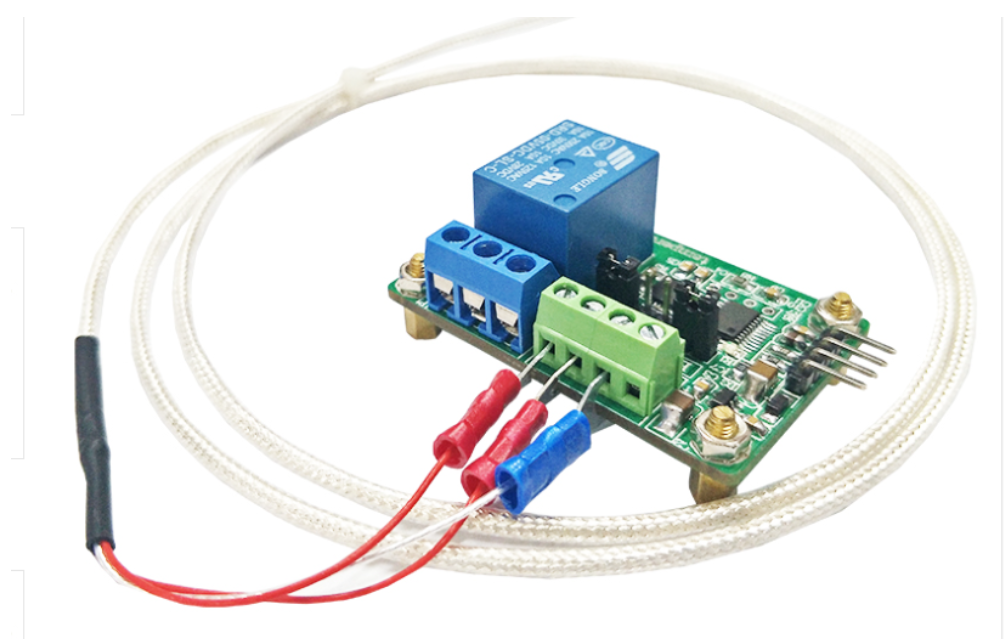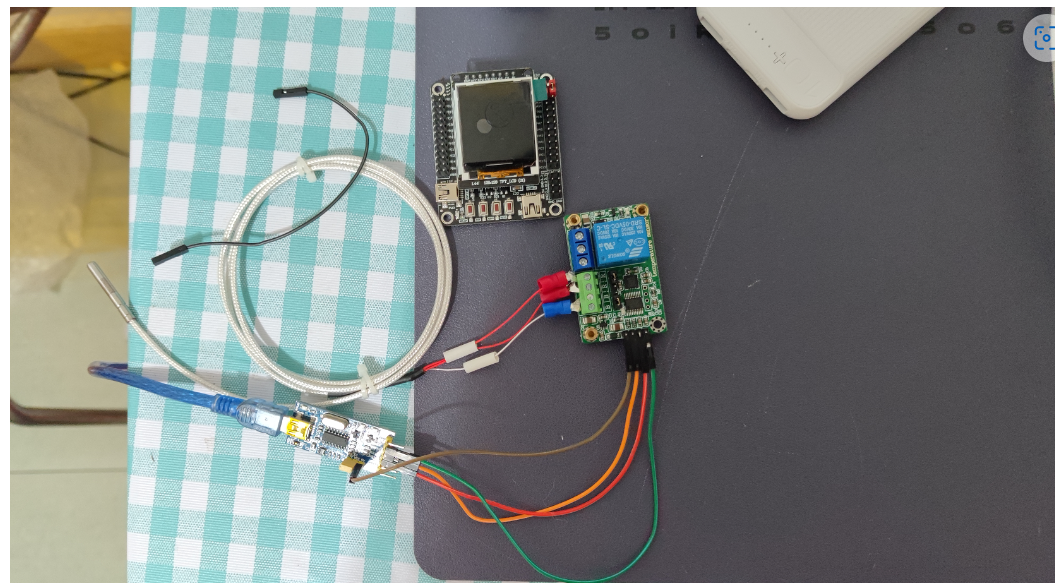炉温检测在现代工业生产中十分重要,因为炉温过高或过低都会对产品质量产生影响,甚至影响工厂的正常运作。因此,设计一款能够精准测量炉温并显示结果的检测仪器具有很大的实用价值。本项目采用了 STM32F103C8T6 作为主控芯片,该芯片拥有丰富的外设和性能较好的计算能力,能够满足该项目对计算和控制的需求。同时,铂电阻 PT100 作为测温传感器,能够提供更加精准的温度测量结果。
一、项目背景
随着工业生产的发展,炉温检测在现代化工、钢铁、电子、玻璃等行业中变得越来越重要。对于这些行业,稳定的生产环境和品质稳定的产品是必须的,而炉温是影响产品品质的重要因素之一。如果炉温过高或过低,都有可能导致产品结构改变、硬度变化、强度下降等质量问题,使得产品不能达到预期的性能指标。此外,炉温不仅会影响产品质量,还会影响设备的使用寿命和工作效率,有时甚至会对整个工厂的正常生产造成影响。
为了防止这些问题的发生,现代化工、钢铁、电子、玻璃等行业需要精准测量炉温并实时地监测炉温变化情况。而本项目即是为了满足这些需求而设计的。采用 STM32F103C8T6 作为主控芯片,它是一款基于 ARM Cortex-M3 内核的微控制器,具有丰富的外设和良好的计算能力,并且易于控制和集成到系统中。同时,铂电阻 PT100 是一种高精度、稳定性好、线性度高的温度传感器,能够提供更加准确的温度测量结果。采用 0.96 寸 IIC 接口的 OLED 屏幕进行显示,操作简便、节省成本,并且具有较好的兼容性和可移植性。
二、设计思路
【1】硬件设计
主控芯片采用 STM32F103C8T6,其内置有多种外设,可满足该项目的需求。铂电阻 PT100 作为测温传感器,能够提供更加准确的温度测量结果。0.96 寸 IIC 接口的 OLED 显示屏幕是本项目的显示工具,能够直观地显示测量结果。
【2】软件设计
软件设计分为数据采集、数据处理和数据显示三个部分。采用 STM32 的 ADC 进行数据采集,通过 PT100 将温度信号转换为电阻信号,再通过 AD 转换器转换成数字信号进行处理。在数据处理中,对 ADC 采样值进行数据校准、滤波处理和算法计算,得到准确的温度值。最后,通过 IIC 总线协议将温度值发送给 OLED 屏幕进行显示,实现实时显示检测结果的功能。
三、代码实现
【1】OLED 显示屏代码
以下是基于 STM32F103C8T6 主控芯片,通过 IIC 接口控制 0.96 寸 OLED 显示屏显示数字的代码:
#include "stm32f10x.h"#include "i2c.h"
#define OLED_ADDRESS 0x78 // OLED IIC地址
void oled_init(void) { OLED_Write_Command(0xAE); // 关闭显示 OLED_Write_Command(0xD5); // 设置时钟分频因子 OLED_Write_Command(0x80); // 重要参数,必须设置,不然屏幕无法上电 OLED_Write_Command(0xA8); // 设置驱动路数 OLED_Write_Command(0x3F); // 默认值 OLED_Write_Command(0xD3); // 设置显示偏移 OLED_Write_Command(0x00); // 默认值 OLED_Write_Command(0x40); // 设置起始行 OLED_Write_Command(0x8D); // 电荷泵设置 OLED_Write_Command(0x14); // 开启电荷泵 OLED_Write_Command(0x20); // 设置内存地址模式 OLED_Write_Command(0x00); // 水平模式 OLED_Write_Command(0xA1); // 段重新映射设置 OLED_Write_Command(0xC0); // 设置COM扫描方向 OLED_Write_Command(0xDA); // 设置COM引脚硬件配置 OLED_Write_Command(0x12); // 默认值 OLED_Write_Command(0x81); // 对比度设置 OLED_Write_Command(0xCF); // 默认值 OLED_Write_Command(0xd9); // 设置预充电周期 OLED_Write_Command(0xF1); // 默认值 OLED_Write_Command(0xDB); // 设置VCOMH OLED_Write_Command(0x40); // 默认值 OLED_Write_Command(0xA4); // 关闭全屏点亮 OLED_Write_Command(0xA6); // 设置显示方式 OLED_Write_Command(0xAF); // 开启屏幕显示}
void OLED_Write_Command(uint8_t cmd) { // 写命令 I2C1_Start(); I2C1_SendByte(OLED_ADDRESS); I2C1_SendByte(0x00); I2C1_SendByte(cmd); I2C1_Stop();}
void OLED_Write_Data(uint8_t data) { // 写数据 I2C1_Start(); I2C1_SendByte(OLED_ADDRESS); I2C1_SendByte(0x40); I2C1_SendByte(data); I2C1_Stop();}
void OLED_Set_Pos(uint8_t x, uint8_t y) { // 设置光标位置 OLED_Write_Command(0xb0+y); OLED_Write_Command(((x&0xf0)>>4)|0x10); OLED_Write_Command(x&0x0f);}
void OLED_Show_Number(uint8_t x, uint8_t y, uint32_t num) { // 在指定位置显示数字 OLED_Set_Pos(x, y); while (num) { uint8_t temp = num % 10; OLED_Write_Data(temp + '0'); num /= 10; }}
int main(void) { RCC_APB2PeriphClockCmd(RCC_APB2Periph_GPIOB, ENABLE); GPIO_InitTypeDef GPIO_InitStructure; GPIO_InitStructure.GPIO_Pin = GPIO_Pin_6 | GPIO_Pin_7; GPIO_InitStructure.GPIO_Mode = GPIO_Mode_AF_OD; GPIO_InitStructure.GPIO_Speed = GPIO_Speed_50MHz; GPIO_Init(GPIOB, &GPIO_InitStructure);
I2C1_Init();
oled_init();
OLED_Show_Number(0, 0, 12345); //在第1行第1列显示数字12345
while (1) { }}
复制代码
首先,通过oled_init()函数初始化 OLED 屏幕,在函数中依次写入了一系列命令,来设置 OLED 的各种参数,例如驱动路数、扫描方向、预充电周期、对比度等。接着,在OLED_Show_Number()函数中,调用了OLED_Set_Pos()函数来设置数字显示的位置,然后通过循环取余数的方法将数字逐位分离,再将其转换为字符型并通过OLED_Write_Data()函数输出到 OLED 屏幕上,最终实现在屏幕上显示指定数字的功能。
【2】温度测量代码
以下是基于 STM32F103C8T6 主控芯片,通过 IIC 接口控制 0.96 寸 OLED 显示屏显示温度,并通过串口打印温度的代码:
#include "stm32f10x.h"#include "i2c.h"#include "usart.h"
#define OLED_ADDRESS 0x78 // OLED IIC地址
// PT100温度转换函数float RTD2Temperature(float R) { float temperature = 0; float RTD_A = 3.9083e-003f; float RTD_B = -5.775e-007f;
temperature = (-RTD_A + sqrtf(RTD_A * RTD_A - 4 * RTD_B * (1 - R / 100))) / (2 * RTD_B); return temperature;}
void oled_init(void) { OLED_Write_Command(0xAE); // 关闭显示 OLED_Write_Command(0xD5); // 设置时钟分频因子 OLED_Write_Command(0x80); // 重要参数,必须设置,不然屏幕无法上电 OLED_Write_Command(0xA8); // 设置驱动路数 OLED_Write_Command(0x3F); // 默认值 OLED_Write_Command(0xD3); // 设置显示偏移 OLED_Write_Command(0x00); // 默认值 OLED_Write_Command(0x40); // 设置起始行 OLED_Write_Command(0x8D); // 电荷泵设置 OLED_Write_Command(0x14); // 开启电荷泵 OLED_Write_Command(0x20); // 设置内存地址模式 OLED_Write_Command(0x00); // 水平模式 OLED_Write_Command(0xA1); // 段重新映射设置 OLED_Write_Command(0xC0); // 设置COM扫描方向 OLED_Write_Command(0xDA); // 设置COM引脚硬件配置 OLED_Write_Command(0x12); // 默认值 OLED_Write_Command(0x81); // 对比度设置 OLED_Write_Command(0xCF); // 默认值 OLED_Write_Command(0xd9); // 设置预充电周期 OLED_Write_Command(0xF1); // 默认值 OLED_Write_Command(0xDB); // 设置VCOMH OLED_Write_Command(0x40); // 默认值 OLED_Write_Command(0xA4); // 关闭全屏点亮 OLED_Write_Command(0xA6); // 设置显示方式 OLED_Write_Command(0xAF); // 开启屏幕显示}
void OLED_Write_Command(uint8_t cmd) { // 写命令 I2C1_Start(); I2C1_SendByte(OLED_ADDRESS); I2C1_SendByte(0x00); I2C1_SendByte(cmd); I2C1_Stop();}
void OLED_Write_Data(uint8_t data) { // 写数据 I2C1_Start(); I2C1_SendByte(OLED_ADDRESS); I2C1_SendByte(0x40); I2C1_SendByte(data); I2C1_Stop();}
void OLED_Set_Pos(uint8_t x, uint8_t y) { // 设置光标位置 OLED_Write_Command(0xb0+y); OLED_Write_Command(((x&0xf0)>>4)|0x10); OLED_Write_Command(x&0x0f);}
void OLED_Show_Temperature(uint8_t x, uint8_t y, float temperature) { // 在指定位置显示温度 OLED_Set_Pos(x, y); int temp = (int)(temperature * 10); for (int i = 0; i < 5; i++) { if (i == 2) { OLED_Write_Data('.'); } else { OLED_Write_Data(temp % 10 + '0'); temp /= 10; } } OLED_Write_Data('C');}
int main(void) { RCC_APB2PeriphClockCmd(RCC_APB2Periph_GPIOB, ENABLE); GPIO_InitTypeDef GPIO_InitStructure; GPIO_InitStructure.GPIO_Pin = GPIO_Pin_6 | GPIO_Pin_7; GPIO_InitStructure.GPIO_Mode = GPIO_Mode_AF_OD; GPIO_InitStructure.GPIO_Speed = GPIO_Speed_50MHz; GPIO_Init(GPIOB, &GPIO_InitStructure);
I2C1_Init();
oled_init();
USART1_Init();
while (1) { float resistance = 100; // 铂电阻的电阻值 float temperature = RTD2Temperature(resistance); // 算出温度值
// OLED显示温度 OLED_Show_Temperature(0, 0, temperature);
// 串口输出温度 char str[32]; sprintf(str, "Temperature: %.1f C\r\n", temperature); USART1_SendString(str);
delay_ms(1000); // 延时1s }}
复制代码
首先,利用RTD2Temperature()函数将铂电阻的电阻值转换为温度值。接着,在OLED_Show_Temperature()函数中,调用了OLED_Set_Pos()函数来设置温度显示的位置,并将温度值逐位分离,通过OLED_Write_Data()函数输出到 OLED 屏幕上,最终实现在屏幕上显示测量的温度的功能。同时,也通过串口输出温度值。
在主函数main()中,不断循环读取铂电阻的电阻值,并通过RTD2Temperature()函数转换为温度值。然后,调用OLED_Show_Temperature()函数将温度显示在 OLED 屏幕上,并调用USART1_SendString()函数通过串口输出温度值。最后,通过delay_ms()函数延时 1 秒,等待下一次测量。













评论